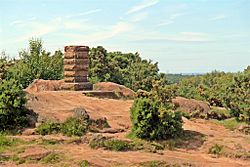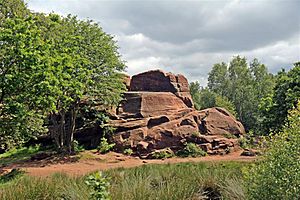Thurstaston Common facts for kids
| Site of Special Scientific Interest | |
 |
|
| Area of Search | Merseyside |
|---|---|
| Coordinates | 53°21′18″N 3°08′06″W / 53.355°N 3.135°W |
| Interest | Biological and Geological |
| Area | 70.8 hectares, 174.9 acres (708,000 m2) |
| Notification | 1954 / 1983 |
Thurstaston Common is a beautiful outdoor area on the Wirral Peninsula in North West England. It covers almost 250 acres (about 100 hectares) of parkland, woods, and open heath. You can find it between the villages of Frankby and Thurstaston.
This special place is owned by two groups: the National Trust, which looks after historic and natural sites, and the Metropolitan Borough of Wirral. Close by, you can also visit Royden Country Park, which has even more things to do.
Thurstaston Common is very important for nature. It is a Site of Special Scientific Interest (SSSI) and also a local nature reserve. This means it's protected because of its unique plants, animals, and geology. From the top of Thurstaston Hill, which is about 298 feet (91 meters) high, you can see amazing views. You can look out over the Dee Estuary (which is also an SSSI!) and even see the Clwydian Hills in North Wales. It's a fantastic spot for families and people who love to walk and explore.
Contents
Why is Thurstaston Common Special?
Thurstaston Common is a protected area because of its amazing natural features. It sits on top of Triassic sandstone, which is a type of rock formed millions of years ago. This special ground helps create many different types of habitats for plants and animals.
Diverse Habitats and Plants
You can find several different environments here. There are wet and dry heaths, which are open areas with low-growing shrubs. There are also marshy grasslands that have acidic soil, and lovely woodlands filled with birch and oak trees.
The heath areas are mostly covered in heather, which makes them look purple when it blooms. You'll also see plants like bilberry, gorse (a spiky bush with yellow flowers), and various types of grass such as wavy hair-grass and heath grass. Other small plants like tormentil, different types of sedge, and heath bedstraw also grow here.
In the wetter, boggy spots, you might find plants like cross-leaved heath and purple moor-grass. There are also special bog plants such as heath rush, common cottongrass (which looks like fluffy cotton), and bog asphodel. Look closely, and you might even spot tiny, meat-eating plants called oblong-leaved sundew and round-leaved sundew!
Birds and Wildlife
Thurstaston Common is also a great place for birds. Many different kinds of birds choose to breed here. Some of the birds you might see include the quick sparrowhawk, the wise tawny owl, and woodpeckers like the great spotted woodpecker and the smaller lesser spotted woodpecker. You could also spot a colourful Eurasian jay, or smaller birds like the redpoll and the linnet.
Thor's Stone: A Rock with a Story
On Thurstaston Hill, you'll find a very large sandstone rock formation known as Thor's Stone. This rock has a lot of interesting stories and legends connected to it.
Viking Legends
In the 1800s, people believed that early Vikings might have used Thor's Stone for religious ceremonies. The Vikings settled in this part of Wirral, especially around Thingwall, during the 10th and 11th centuries. So, it made sense to some that they might have used this impressive rock.
An old story from 1888 even said that local children used to dance around the stone once a year. They called it 'Fair Maiden's Hall'.
What Geologists Think Now
Today, scientists who study rocks (geologists) and historians believe that Thor's Stone is a natural rock formation. It's similar to a "tor," which is a large, free-standing rock outcrop often found on hills. It was likely shaped by natural weather processes over a very long time. Later, in the 1700s and 1800s, quarrymen (people who cut stone from the ground) might have worked on it, changing its shape a bit. So, while it has a cool legend, it's probably a natural wonder!
Images for kids
-
Looking towards Arrowe Park and Liverpool.
-
The view to Point of Ayr.






